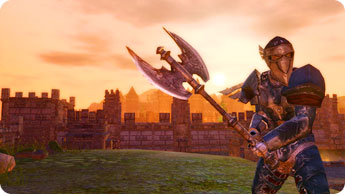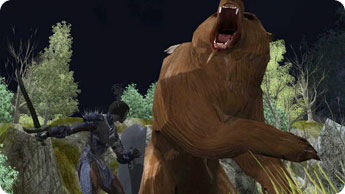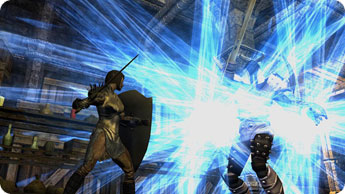Oh the Characters You’ll Be
Your choice of race and class confers a variety of bonuses and special abilities, so choose wisely. As you create your character, you can see how your decisions will affect it, and you can backtrack if you want to change something. You can select more than one class, but not all classes mesh well with each other, and you’ll advance in levels more slowly than you would with one class. Your achievements in the game allow you to later add a prestige class that further refines your character.
| Barbarian |
Fast and agile, barbarians can also throw themselves into a rage that temporarily increases their strength and constitution but diminishes their armor class. |
Fighter, Ranger |
Paladin, Monk |
Blackguard, Weapon Master, Dwarven Defender |
| Bard |
This wandering minstrel’s songs boost companions’ abilities, and her wisdom allows easier identification of mysterious items. |
Typically don’t multi-class |
- |
Red Dragon Disciple, Duelist, Eldritch Knight |
| Cleric |
Good for what ails you, this character class is perfect for those who want to channel divine energy into their adventures. |
Typically don’t multi-class |
- |
Divine Champion, Blackguard, Warpriest |
| Druid |
At one with nature, druids draw spellcasting power from the environment and can turn into animals. |
Typically don’t multi-class |
- |
Typically don’t choose one |
| Fighter |
Every party needs at least one of these. |
Barbarian, Paladin, Ranger, Rogue, Monk |
- |
Blackguard, Dwarven Defender, Frenzied Berzerker, Duelist, Divine Champion, Weapon Master, Arcane Archer |
| Monk |
He eschews weapons and armor, yet he is deadly in combat. A monk can’t cast spells but can channel an energy known as ki to enhance his attacks. |
Rogue, Fighter, Paladin |
- |
Assassin, Shadowdancer |
| Paladin |
Followers only of good, paladins cast healing spells, turn back the undead, and swing a mean weapon. |
Fighter, Ranger, Monk |
Bard, Barbarian |
Divine Champion |
| Ranger |
Deadly with a bow and at home in the woods, a ranger can also cast some druid-like spells. |
Barbarian, Fighter, Paladin, Rogue |
Druid |
Duelist, Divine Champion, Arcane Archer |
| Rogue |
Skilled at slipping in and out of places undetected, rogues use their abilities for good or evil. |
Typically don’t multi-class, although some wizard or sorcerer abilities don’t hurt |
- |
Assassin, Duelist, Arcane Trickster (if using magic), Shadowdancer, Shadow Thief of Amn |
| Sorcerer |
They draw their magic from an innate power; some claim to have a little dragon ancestry in them. |
Typically don’t multi-class |
- |
Pale Master, Arcane Trickster |
| Warlock |
Their powers are supernatural in origin, and thus they don’t memorize spells. |
Typically don’t multi-class |
- |
Don’t qualify for any that require spellcasting abilities |
| Wizard |
The classic D&D magic-user, this class must memorize spells before using them. |
Typically don’t multi-class |
- |
Arcane Archer, Pale Master, Eldritch Knight |




